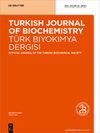不同绝色图塔菌株对阿维菌素的抗性分析(鳞翅目:蠓科
IF 0.7
4区 生物学
Q4 BIOCHEMISTRY & MOLECULAR BIOLOGY
Turkish Journal of Biochemistry-turk Biyokimya Dergisi
Pub Date : 2014-01-01
DOI:10.5505/TJB.2014.09327
引用次数: 18
摘要
目的:番茄叶螨(鳞翅目:蠓科)是一种寡食昆虫。赤眼蜂的幼虫尤其能破坏番茄植株,对这一经济作物造成重大的产量损失。在世界各地的农业地区,通过杀虫剂进行化学控制一直是控制它的主要方法。然而,继续使用某些已登记的杀虫剂,如阿维菌素,可能会导致赤眼蜂产生抗药性。本研究采用生物测定和生物化学方法,对土耳其3个地区的绝对白田鼠种群中阿维菌素杀虫剂的抗性状况进行监测,并分析该杀虫剂的抗性机制。方法:生物测定法和生化法。结果:生物测定结果显示,阿达纳菌株和安塔利亚菌株对阿维菌素的抗性较低(分别为3.03和2.3倍),安卡拉菌株对阿维菌素无抗性(1.31倍)。生化分析显示,与易感人群相比,阿达纳和安塔利亚野外种群CYP450-PNOD活性分别提高了2.55倍和1.95倍。GST-CDNB活性仅在Adana人群中升高1.3倍,差异有统计学意义(p<0.05)。虽然EST-α-NA活性仅在安卡拉种群中升高了3.41倍,但安卡拉种群对阿维菌素的抗性不明显。结论:因此,细胞色素P450单加氧酶可能在土耳其野田鼠对阿维菌素产生抗性的过程中起主要作用。此外,甘油三酯还可能具有降低田间稻瘟病菌阿维菌素代谢过程中产生的氧化应激等支持作用。本文章由计算机程序翻译,如有差异,请以英文原文为准。
Analysing resistance of different Tuta absoluta (Meyrick) (Lepidoptera: Gelechiidae) strains to abamectin insecticide
Objective: Tuta absoluta (Meyrick) (Lepidoptera: Gelechiidae), tomato leafminer, is an oligophagous insect. Larvae of T. absoluta can destroy especially tomato plants which lead to important yield loss in this economically valuable crop. Chemical control through insecticides has been a main method of controlling it in farming areas all over the world. However, continues application of certain registered insecticide such as abamectin might lead to resistance development in T. absoluta. The aim of this study was to monitor resistance status of abamectin insecticide and analyse resistance mechanisms of this insecticide in T. absoluta field populations from three districts of Turkey by using bioassay and biochemical methods. Methods: Bioassays and Biochemical assays. Results: Bioassay results showed that while Adana and Antalya strain of T. absoluta showed low resistance (3.03and 2.3-fold) to abamectin insecticide, Ankara strain of T. absoluta was not resistant to abamectin (1.31-fold). Biochemical analysis displayed that CYP450-PNOD activities showed 2.55 and 1.95-fold increase compared to susceptible population in Adana and Antalya field populations, respectively. Furthermore, GST-CDNB activities showed statistically significant (p<0.05) 1.3-fold increase only in Adana population. Although EST-α-NA activities showed 3.41-fold increase only in Ankara field population, this field population did not display a significant resistancy to abamectin. Conclusion: Consequently, cytochrome P450 monooxygenase enzymes seemed to have a major role in abamectin resistance development in field populations of T. absoluta from Turkey. In addition, GSTs possibly have supportive role such as reducing oxidative stress that developed during metabolism of abamectin in resistant field populations of T. absoluta.
求助全文
通过发布文献求助,成功后即可免费获取论文全文。
去求助
来源期刊
CiteScore
1.20
自引率
0.00%
发文量
0
审稿时长
6-12 weeks
期刊介绍:
Turkish Journal of Biochemistry (TJB), official journal of Turkish Biochemical Society, is issued electronically every 2 months. The main aim of the journal is to support the research and publishing culture by ensuring that every published manuscript has an added value and thus providing international acceptance of the “readability” of the manuscripts published in the journal.

 求助内容:
求助内容: 应助结果提醒方式:
应助结果提醒方式:


